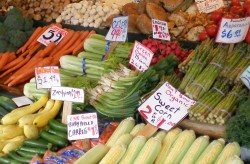Food Desert or Not?
Researchers claim urban food deserts don’t exist, but it’s a lot more complicated than that.
A lawyer friend of mine and I have a running joke. Whenever I ask him a seemingly simple yes-or-no legal question, he pauses. Then he sighs and says, “Well … it’s complicated.” And so it goes for me when people ask me questions about getting more healthy food into North Side Milwaukee. It’s complicated.
It came up again recently when some friends asked me if I’d seen the New York Times article about two new studies that have failed to establish a connection between obesity and a lack of full service grocery stores in poor neighborhoods – a linkage that many of my colleagues and I have accepted as fact.
To be fair to these researchers, they have a difficult task. They want to conduct their studies on a grand scale so the conclusions are applicable across the United States. But the sheer scale of their work makes it impossible to sit down and talk to the people most affected by healthy food scarcity. What gets lost are the local stories.
It’s like trying to measure outdoor exercise opportunities for children by counting playgrounds from a helicopter. Yes, you can fly over Milwaukee and count the total, but unless you visit each playground you won’t know if the swings are working or if wood chips are in place so kids don’t hurt themselves. An urban planning colleague of mine calls this “ground truthing.”
To get an accurate picture of what’s going on, you need to visit residents and ask if their kids actually use the playground. It could be the playground isn’t used because it’s surrounded by trees that prevent a dad from watching his children from the front porch, or because there are no safe crosswalks leading to the park, or because children have found used condoms and hypodermic needles. Most researchers don’t have the funding for this level of detail, so they extrapolate their conclusions from huge impersonal databases from the Census Bureau or the state Department of Motor Vehicles. And it ends up like trying to paint a 4-inch canvas with a 4-inch brush.
If these researchers were to talk to corner store operators, they would discover many don’t have the space or electrical wiring to run refrigerated produce display cases, and their landlords don’t want to make these kinds of upgrades because they don’t want to pay higher taxes.
It’s complicated. But the good news is that the needle is moving in Milwaukee because hundreds of people in our city are working at the healthy food access issue from a mind boggling array of angles. We have urban gardening proponents, entrepreneurs, indoor fish growers, community organizers, and urban planners that are putting their own personal spin on the issue. They’re having conversations and developing real relationships with residents, farmers, gardeners, and corner store owners. All of their solutions are hyper-local. Milwaukee’s food system will eventually look like a quilt made of little fabric squares that reflect neighborhood histories and cultures and aspirations. A North Side solution will look different than a remedy on the South Side. What many national-scale researchers want is one big homogenous blanket woven from the same thread. They’re looking for the forest and missing all the trees.
It’s complicated, yes, but Milwaukee has its advantages. It’s a small city. It’s easier to get to know people and to develop the kinds of relationships that lift projects off the ground in Milwaukee than Los Angeles, Chicago, or New York. We are also quite naïve. We’re not too cynical to try something that the experts call crazy. When it comes to healthy food access, Milwaukee is like a miniature Silicon Valley. Just as Apple started in a garage, tomorrow’s Will Allen is probably sitting with her laptop in an Alterra Café, plotting, blogging, and dreaming. I can’t think of a more exciting place to be.
Urban Foodie Question of the Week:
Back when I was in college, I remember watching in horror one day as a classmate made himself a banana and mayonnaise sandwich. An informal poll on my Facebook page revealed a lot of high school classmates from North Carolina that grew up eating them. Thanks to the internet I’ve learned that this was another make-do dish that emerged out of the Great Depression. Last month I finally made one for myself and it wasn’t bad. Diet be damned, I actually ate the whole thing. The key to this recipe is Wonderbread. Put some South in your mouth and try it.
Which brings me to my question for readers: have you encountered any banana and mayo sandwiches in Wisconsin? If so, share your stories in our comments section.
Urban Foodie
-
The Junk Food Debate
 May 14th, 2013 by Young Kim
May 14th, 2013 by Young Kim
-
Tips for Twenty-Somethings
 Mar 15th, 2013 by Young Kim
Mar 15th, 2013 by Young Kim
-
Why Hmong-Grown Produce is Different?
 Dec 5th, 2012 by Young Kim
Dec 5th, 2012 by Young Kim























“If these researchers were to talk to corner store operators, they would discover many don’t have the space or electrical wiring to run refrigerated produce display cases, and their landlords don’t want to make these kinds of upgrades because they don’t want to pay higher taxes.”
There’s the reason we don’t do things & the reason we say we don’t do things. I know this is a tangent but really taxes, that’s the reason landlords/business owners won’t upgrade their properties? If only there were lower taxes, there would be arugula on every corner, ha!
If it was profitable for small-time operators to sell lots of great produce, well I think they would find a way. I walk into many small convenience stores & there are plenty of coolers… full of soda & beer, every once in a while I see some milk and maybe a bunch of bananas on the counter.
If people wanted to buy it, I’m guessing it would be alot easier to get others to sell it to them.
Well, “taxes” and “subsidies” do have something to do with it. Junk food, and processed meat is massively subsidized in this country which makes it far easier for someone to sell it at a profit and for people to buy it.
Fresh veggies, and most healthy food, are not subsidized. Draw your own conclusions.
Check out the way corner stores can retrofit and be successful over at http://www.healthycornerstores.org. There are success stories, but merchants have to be creative and understand what their customers will try, will buy, and will buy again. There are ways to get local produce into those stores by creating alternative food hubs to bypass the mass wholesalers. But mostly, people need to learn, believe, and act on the fact that whole foods won’t kill you and hot fries will!
Peanut butter and pickles Young, but no bananas and mayo. But I’m Milwaukee born and raised, so that must explain it.
Out of the never published because it was never actually written Mother Mary Jane’s Cook Book, I call “365 ways to use hamburger in your main meal” is the Minnesota version of SOS. browned hamburger with canned mushrooms, thickened with flour and served over rice or mashed potato’s. Canned green beans were a side dish. Desert was Date-nut-rolled cookies
I’d like to know more about your group, and how to stay in touch with the movement.
My sandwich is a banana, peanut butter and tomato sandwich on whole wheat toast!
Great use for all those tomatoes coming ripe in the next weeks!
Great article. Even if the researchers were not able to find a link between urban obesity and the quality of the groceries available, that in no way indicates that the better sources of fresh food is not a significant solution to obesity. Causal relationships are very hard to “prove” which often fly’s in the face of what we observe and know to be true.
@Jesse: It’s a chicken-and-egg situation. Residents have given up on getting vegetables at corner stores because they don’t have them. That’s what happens when every time you visited a store the only thing you see for sale is Doritos and Night Train. Any effort to get produce into a corner store has to be married with a massive neighborhood PR effort to make residents aware that the stuff is there. Otherwise the whole thing will fail.
Our produce distribution system has undergone a massive consolidation process and now everyone is geared to serve the big accounts: Walmart, Pick-n-Save, Sentry, etc. There are no small niche produce wholesalers anymore. Is there a way to serve all these corner stores and still break even or make a profit? That’s the $1,000,000 question.
Wonderfully thought-provoking article, yet inspiring when you think about all the innovative, local approaches being implemented in SE WI.
Peanut butter & lettuce sandwiches…both my mom and partner love them. I had never tried it until recently (thinking it was too weird) but with a good crunchy, crispy lettuce, it’s pretty good!
Imagine this! In the 1940s Mr. Fricano’s truck came ’round my neighborhood twice a week with fresh seasonal fruits and vegetables. Why can’t some enterprising entrepreneur do the same today? That would solve the access problem. Oh yes, then Kohl’s Food Store moved into the neighborhood and Mr. Fricano disappeared. Sad. No?
@DHRichards … there are tons of projects going on in Milwaukee. I’m afraid of listing them for fear of leaving out someone important, but here they are (in alphabetical order):
– Alice’s Garden
– Center for Resilient Cities
– Fondy Food Center (my org)
– Growing Power
– Groundwork Milwaukee
– Milwaukee Urban Gardens (aka, MUG)
– Sweet Water Foundation
– Walnut Way Conservation Corp.
– Victory Garden Initiative
Google them and you’ll be able to look into each one. Keep in mind that this is a crazy time of year and people may be slow in responding.
Cheers.
– Young
@Edith Wagner: Yes, you’re right. At one point there were many small carts crisscrossing our city with fresh produce. But at some point (my guess it started with World War II), everyone realized that to make a profit you had to get bigger. This “go big or go home” theme continues to this day … and it doesn’t just apply to food. Look at what’s happening with finance and auto industries.
SHARE Wisconsin launched a mobile market truck about a year ago and its since been taken over by SET Ministry, Inc. Here’s a story on this effort:
http://www.milwaukeenns.org/2012/06/28/united-way-donation-keeps-mobile-market-trucking/
@Young Have you heard about Green Carts in NYC? http://www.good.is/post/food-desert-solution-new-york-s-green-carts/ Sounds like a very interesting idea to me, as far as getting fresh food out into the neighborhoods.
More on food deserts at http://www.fooddeserts.org
@Dave Reid – Yes, I have. It’s an intriguing idea and one that I’ve not had the time to investigate much. As a big believer in playing the hand you’ve been dealt, I suspect the outdoor carts have done well in NYC because real estate is so precious there. But what do they do in the winter? Here it gets too cold to have produce outside.
@Hillary Shaw – Thank you for that! It looks like folks in the UK have the same concerns that we do.
– Young